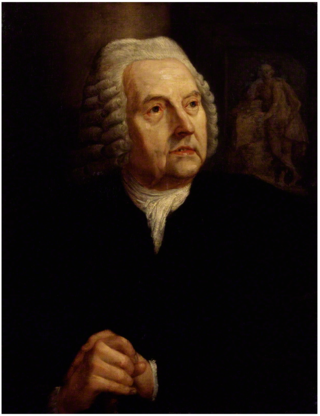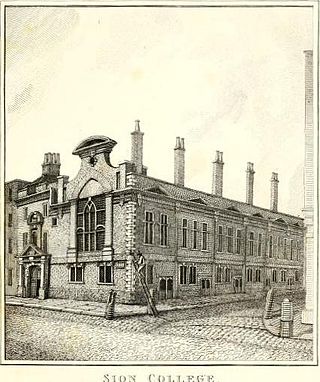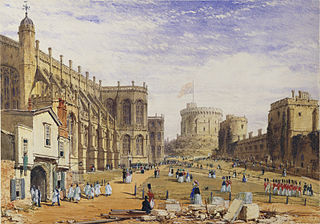
Peter Scheemakers or Pieter Scheemaeckers II or the Younger was a Flemish sculptor who worked for most of his life in London. His public and church sculptures in a classicist style had an important influence on the development of modern sculpture in England.
The Vicar of Bray is a satirical description of an individual fundamentally changing his principles to remain in ecclesiastical office as external requirements change around him. The religious upheavals in England from 1533 to 1559 made it impossible for any devout clergyman to comply with all the successive requirements of the established church. The original figure was the vicar Simon Aleyn, although clerics who faced vicissitudes resulted in revised versions of the story.

Earl of Suffolk is a title which has been created four times in the Peerage of England. The first creation, in tandem with the creation of the title of Earl of Norfolk, came before 1069 in favour of Ralph the Staller; but the title was forfeited by his heir, Ralph de Guader, in 1074. The second creation came in 1337 in favour of Robert de Ufford; the title became extinct on the death of his son, the second Earl, in 1382. The third creation came in 1385 in favour of Michael de la Pole. The fourth creation was in 1603 for Lord Thomas Howard, the second son of Thomas Howard, 4th Duke of Norfolk, by his second wife Margaret Audley, the daughter and eventual sole heiress of Thomas Audley, 1st Baron Audley of Walden, of Audley End in the parish of Saffron Walden in Essex. Howard was a prominent naval commander and politician and served as Earl Marshal, as Lord Chamberlain of the Household and as Lord High Treasurer. In 1597 he was summoned to Parliament as Baron Howard de Walden, and in 1603 he was further honoured, at the start of the reign of King James I, when he was created Earl of Suffolk. His second son the Hon. Thomas Howard was created Earl of Berkshire in 1626.
"The Vicar of Bray" is an eighteenth century satirical song recounting the career of The Vicar of Bray and his contortions of principle in order to retain his ecclesiastic office despite the changes in the Established Church through the course of several English monarchs. The song is particularly interesting because of the number of allusions to English religious and political doctrines and events crammed into it, justifying the close reading and annotation given here.

Whittington is a village and civil parish which lies approximately 3 miles south east of Lichfield, in the Lichfield district of Staffordshire, England. According to the 2001 census it had a population of 2,591, increasing to 2,603 at the 2011 Census. The parish council is a joint one with Fisherwick. The Coventry Canal borders the village to the north and east.

Bray, occasionally Bray on Thames, is a suburban village and civil parish in the Windsor and Maidenhead district, in the ceremonial county of Berkshire. It sits on the banks of the River Thames, to the southeast of Maidenhead of which it is a suburb. The village is mentioned in the comedic song "The Vicar of Bray". Bray contains two of the nine three-Michelin-starred restaurants in the United Kingdom and has several large business premises including Bray Studios at Water Oakley, where the first series of Hammer Horror films were produced.
The Dean of the Chapel Royal, in any kingdom, can be the title of an official charged with oversight of that kingdom's chapel royal, the ecclesiastical establishment which is part of the royal household and ministers to it.

Sion College, in London, is an institution founded by royal charter in 1630 as a college, guild of parochial clergy and almshouse, under the 1623 will of Thomas White, vicar of St Dunstan's in the West.

Frilsham is a village and civil parish 4 miles (6.4 km) from Newbury, in the English county of Berkshire.

The Dean of St Patrick's Cathedral is the senior cleric of the Protestant St Patrick's Cathedral, Dublin, elected by the chapter of the cathedral. The office was created in 1219 or 1220, by one of several charters granted to the cathedral by Archbishop Henry de Loundres between 1218 and 1220.

White Kennett was an English bishop and antiquarian. He was educated at Westminster School and at St Edmund Hall, Oxford, where, while an undergraduate, he published several translations of Latin works, including Erasmus' In Praise of Folly.
This article is about the particular significance of the year 1822 to Wales and its people.

St Michael's Church is in the town of Kirkham, Lancashire, England. The church is recorded in the National Heritage List for England as a designated Grade II* listed building. It is an active Anglican parish church in the diocese of Blackburn, the archdeaconry of Lancaster and the deanery of Kirkham.

The Dean and Canons of Windsor are the ecclesiastical body of St George's Chapel at Windsor Castle.
William Levett was the Oxford-educated personal chaplain to Edward Hyde, 1st Earl of Clarendon, whom he accompanied into exile in France, then became the rector of two parishes, and subsequently Principal of Magdalen Hall, Oxford and the Dean of Bristol.

The Dean of Bristol is the head of the Chapter of the Cathedral Church of the Holy and Undivided Trinity, Bristol, England. The Dean is Mandy Ford, since her installation on 3 October 2020.
Vicar of Bray may refer to:

The Prebends of Southwell were the benefices held by the Prebendaries, or Canons, of Southwell Minster.

The Chaplain to the Speaker of the House of Commons, also known as the Speaker's Chaplain, is a Church of England priest who officiates at services held at the Palace of Westminster and its associated chapel, St Mary Undercroft. The Chaplain also acts as chaplain to the Speaker and Members of Parliament. The first Speaker's Chaplain was appointed in 1660. The current officeholder is Patricia Hillas.

St Alban's Church, Holborn, is a Church of England parish church in Holborn, central London, for a time becoming one of two churches of its parish which retains the name and St Peter's Saffron Hill to serve the mixed-use zone, notable for jewel-setting and for law firms. It has been Grade II* listed since 1951. This land is commonly – other than mainly to state Holborn, meaning part of Holborn – called Hatton Garden. St Peter's church is defunct, rationalising the number of churches in line with population changes of the district.
















